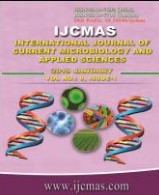


 National Academy of Agricultural Sciences (NAAS)
National Academy of Agricultural Sciences (NAAS)

|
PRINT ISSN : 2319-7692
Online ISSN : 2319-7706 Issues : 12 per year Publisher : Excellent Publishers Email : editorijcmas@gmail.com / submit@ijcmas.com Editor-in-chief: Dr.M.Prakash Index Copernicus ICV 2018: 95.39 NAAS RATING 2020: 5.38 |
One of the major constraints to crop production is the biotic stress which is being caused by various fungi, bacteria and viruses. Successful management of plant disease is mainly dependent on the accurate and efficient detection of plant pathogens, amount of genetic and pathogenic variability present in pathogen population, development of resistant cultivars and deploying of effective resistance gene in different epidemiological region. In case of most of the fungal and bacterial diseases, the main reason for frequent “breakdown” of effective resistances is the variability that exists in the pathogen population, which necessitates a continual replacement of cultivars due to disease susceptibility. Mechanism of variability in case of fungi includes mutation, recombination, heterokaryosis, parasexulaism, heteroploidy and in bacteria are conjugation, transformation and transduction. Variability in viruses is generated by mechanisms of recombination, reassortment and mutation. The conventional methods for identifying the variability in the pathogens at species, subspecies and intra sub species level is being done by study of virulence reactions using disease rating scales on set of host differentials. Molecular techniques are more precise tools for differentiation between species, and identification of new strains/ isolates. Biotechnological methods can be used to characterize pathogen populations and assess the genetic variability much more accurately. Molecular methods (RAPD, RFLP, AFLP, SSR, ISSR and rDNA markers) are being used to distinguish between closely related species with few morphological differences and to distinguish strains within species. These markers can detect differences at single base pair level and has been successfully used for detection of fungi and bacteria. In future, the development of simple PCR based protocols that can be used to detect the pathogen population present in the farmers’s fields. So that we can use selective breeding lines with specific resistance to a particular pathotype. These resistance (QTL) can be utilized in developing varieties and hybrid cultivar with higher levels of disease resistance.
 |
 |
 |
 |
 |